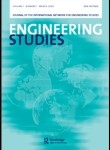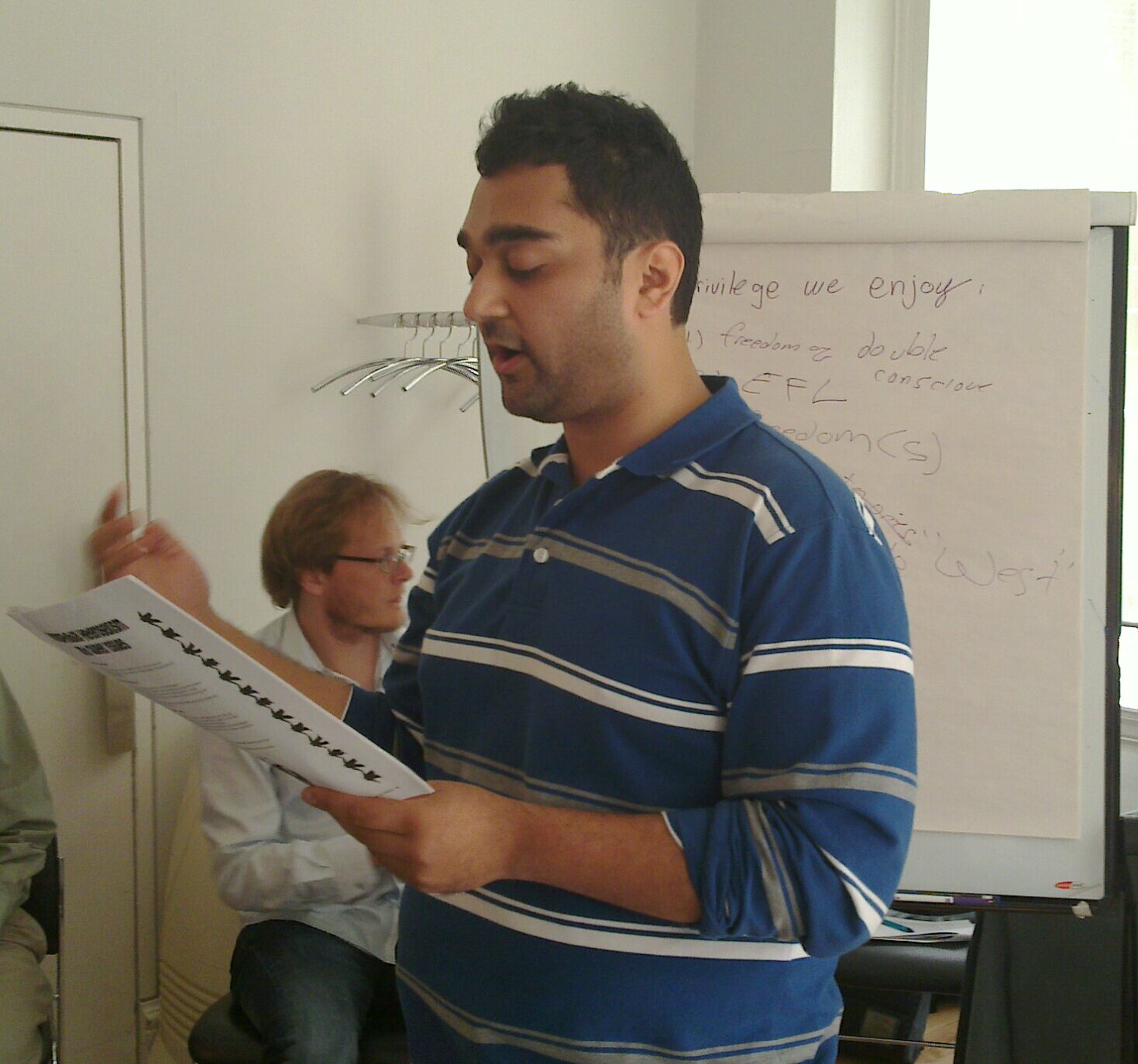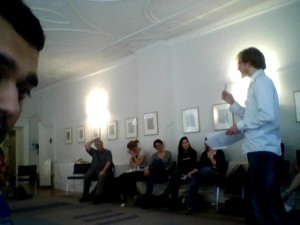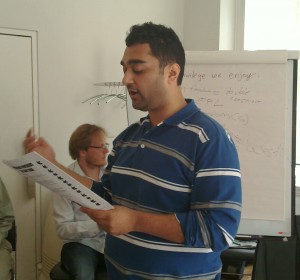 Dean and Donna are featured on the RPI website.
Dean and Donna are featured on the RPI website.
Author Archives: admin
Usman speaking about racism…

Moving into the cosmos
Caroline led us in thinking about us as a “movement”. She asked Katy to create a liminal space out of the people at the conference to represent what she felt about ESJP. This resulted in the next 10 or so minutes with Katy silently arranging people to create a “living sculpture”. Caroline then invited attendees to share their feelings on what it felt to be included in the space and not included in that space. This was a technique from the “theatre of the oppressed” as theorized by Boal.
ESJP as a movement:
Then the conference participants were encouraged to go talk to their critical friend about goals for this conference. Katy cited the lack of industry partners as a point of concern, while others felt that their goal of learning more was very much reached as there was lots of information to process. My critical partner had the goal of rejuvenating during the conference by meeting old and new friends, which she did meet during the conference. Dean was interested in contributing to the sustainability of the ESJP community during the conference. Lizzie felt that she had several critical conference friends and they contributed greatly to her thinking.
Caroline pointed to Donna to address the critique of industry partners being absent. Donna said that “During this conference, many forms of oppression were put on the table like racism. It doesn’t mean white people aren’t welcome, it just means they have to acknowledge racism and deal with it. In the same way, capitalism is a form of oppression. Folks from industry are welcome as long as they are willing to critique capitalism”.
Caroline says that ESJP must allow those who are members of this “community” or “movement” to critical engage with dominant discourses in engineering and challenge the “business as usual” model in the engineering world. Dean added that it’s not just being critical of the corporate world but also critical of dominant institutions and structures.
Caroline addressed the issue of tension between newcomers to the social justice space and those who have more experience with it. Then she talked about ongoing activities in the ESJP network:
- PAR Research – Dean’s PAR project
- Book series
- Workshops
- Zine
- Online modules
- Next Conference
Q&A for Session 2 (Juan and Jen’s presentations)
Doug: The engineers have supplied to the business community a reason for reducing smoke in their own terms. But it doesn’t actually deal with the exploitive nature of those businesses. You shouldn’t reduce smoke just because it makes business sense.
Peter: The business case solution doesn’t provide a long-term solution. But we should ask ourselves if it works towards justice right now? It’s not a great long-term or complete solution, but it works towards that goal.
Jen: There’s a tension in the case of Rico between the community and the greater community of those who will be supplied with the electricity.
Donna: Energy deregulation in the US has caused many problems. You have deregulation without competition so energy is very expensive and controlled by monopolies.
Jen: Rico is not a wealth community so they could not run a energy coop like some other communities in Colorado.
Lily: I’m from Engineers against Poverty and we work to make the “business case” in the developing world because we think it’s important.
Arias: I’d love to see more of these histories but I think engineers sometimes concentrate too much on the technical fix and not enough in defining the problem.
Darko: I think we need to make the business case because they won’t change unless you force them to by showing that they can’t afford to.
Jon: I feel that one theme running in all these comments is the “triple bottom line” (social, environmental, economic). In some case studies, one or more of these factors are considered more than others.
Caroline: I think we’ve spent too much time thinking of the economic factor. We, as a community, need to be more worried about the social and environmental. Then maybe….maybe….we can talk about economics. We need to actually critique this economic factor much more. I want to smash the triple bottom line because it’s not easy equal categories. It’s more a muddle.
Session 2 (Friday)
Blood, Energy, and Justice
Jen presented her work with a community group in Rico, United States developing geothermal energy sources. It’s some recent work that shes gotten involved with just this past summer.
She started her presentation by talking about our current energy moment in which coal accounts for 49% of our energy production and renewables account for 3% while energy consumption seems to be going up. What is our future look like then with respect to energy?
To answer this question, Jen looked at historical models of energy extraction. For example, oil was extracted in a model that valued speed, optimization of extraction, profit, privately-owned. In her new project, Jen sees the possibility of a new model of energy extraction that values community.
Citizens of Rico are concerned with where the profits will go, where the energy will go, who will own the system.
Engineers and Industrial Smoke
Juan asked the question if social justice and engineering are incompatible fields? If so, are there moments in history where engineers were concerned with justice? Juan points to the Progressive Era (1880-1920) in the United States an an example of the moment. He drew from various histories such as David Stradling’s “Smokestacks and Progressives”.
Through David’s history and other histories, Juan found out how smoke was associated with industrialization and progress during the rapidly industrializing Progressive Era. Of course, this smoke led to environmental pollution and health problems. Engineers were not concerned with it until women’s groups began to define the problem for engineers and physicians. By the mid 1910s, engineers began to agree that the smoke problem has technical fixes and smoke control can make business more efficient. During this moment, engineers began to equate efficiency (smoke reduction) with profits. In this way, engineers were legitimized (at least in the eyes of industrialists) as researchers.
Juan concluded his presentation by asking if:
- When engineers perform technical work in terms of efficiency, are they being agents of social justice?
- Could we look at other existing stories of engineers in similar ways? What would be their political function in the classroom?
- In the process of defining a problem and its solution from lay to expert terms, non-engineers are marginalized. What does that mean for engineers interested in justice?
Usman speaking about racism…
Q&A for Session 2 (Juan and Jen’s presentation)
Doug: The engineers have supplied to the business community a reason for reducing smoke in their own terms. But it doesn't actually deal with the exploitive nature of those businesses. You shouldn't reduce smoke just because it makes business sense.
Session 2 (Friday)
- When engineers perform technical work in terms of efficiency, are they being agents of social justice?
- Could we look at other existing stories of engineers in similar ways? What would be their political function in the classroom?
- In the process of defining a problem and its solution from lay to expert terms, non-engineers are marginalized. What does that mean for engineers interested in justice?
Engineers Against Poverty Panel (cont.)
Meena: Caste system in India is social inequity reinforced by structural, cultural, and religious inequity. The job of Dalits is to collect feces. How can we convince them to give up their jobs? It requires external pressure but also internal pressure.
Notes from Katy from the “Access to engineering education” panel
The talk was framed around the topic of social mobility. Matthew talked about access to universities and degree programs in terms of graduate premiums and professional status of their graduating students.
There is an underrepresentation of women and those from a lower socio-economic status in engineering classrooms.
Efforts are underway to address these issues.
1.building the business case of a diverse engineering workforce
a.by showing that creativity is increased
b.by showing that complex difficult questions are better solved
c.by showing that highly skilled graduates are good for competition
2.conducting outreach in schools through activities that are appropriate and relevant to the area, and that include a role model
3.getting engaged with the mainstream education process of STEM learner hours:
a.extracurricular engagement:
a.i.recruitment
a.ii.understanding what engineering is all about
a.iii.building an identity (that can be very fragile)
b.curricular engagement:
b.i.help to develop curriculum
b.ii.make sure it is relevant
b.iii.build self efficacy
Notes from Lisa McLoughlin
The talk followed the path of a person with practical skills (but no math background) who has opted to start at community college to their final destination of graduating from a four-year engineering program, and the questions that arise along the way. Who are they? Are they in the right place?
There needs to be a balance between abstract and applied content, including for evaluation for grades. There is a link through design. Students can close the apparent rift by completing a project in which theory and design are valued.
Students are taught to “learn to learn” so that they understand that various outcomes are valuable.
Structural accommodations allow for a diversity of students to have access to education. Many ‘non-traditional’ students attending community college for engineering are, for example, returning-learners, parents, part time, or low socio-economic status, so providing night classes or alternate models of delivery of material will allow them to attend. Providing a clear list of accepted welcomed pathways would also help.
Discussion
There was discussion around the ‘business case’ model and its effectiveness for this application.
There was a comment about giving students credit for prior experience, as long as it included a reflection process about the experience. This helps to bridge the gap.
Comments were made about the need for a positive identity for engineering students.
Outreach programs were discussed: need to get many schools involved and make the experience authentic and relevant.
Increasing tuition fees in the US/UK were discussed. US = self-destruct; UK = little effect so far, but larger changes coming that might change the picture.


